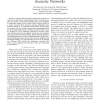Free Online Productivity Tools
i2Speak
i2Symbol
i2OCR
iTex2Img
iWeb2Print
iWeb2Shot
i2Type
iPdf2Split
iPdf2Merge
i2Bopomofo
i2Arabic
i2Style
i2Image
i2PDF
iLatex2Rtf
Sci2ools
GLOBECOM
2008
IEEE
2008
IEEE
MACA-U: A Media Access Protocol for Underwater Acoustic Networks
—Unlike terrestrial wireless communication which uses radio waves, underwater communication relies on acoustic waves. The long latency and limited bandwidth pose great challenges in underwater Media Access Control (MAC) protocol design. As a result, terrestrial MAC protocols perform inefficiently when deployed directly in an underwater environment. In this paper, we examine how an existing asynchronous handshaking based protocol called Multiple Access Collision Avoidance (MACA) can be adapted for use in multi-hop underwater networks. Three areas of improvement are investigated, namely, the state transition rules, the packet forwarding strategy, and the backoff algorithm. Throughput performance is also evaluated through extensive simulation in multi-hop underwater networks. Due to its simplicity and throughput stability, our proposed MAC protocol can be adopted as a reference MAC protocol for underwater networks, with which a more sophisticated underwater MAC may benchmark its perfor...
| Added | 29 May 2010 |
| Updated | 29 May 2010 |
| Type | Conference |
| Year | 2008 |
| Where | GLOBECOM |
| Authors | Hai-Heng Ng, Wee-Seng Soh, Mehul Motani |
Comments (0)

